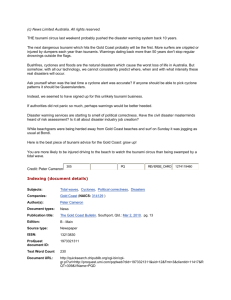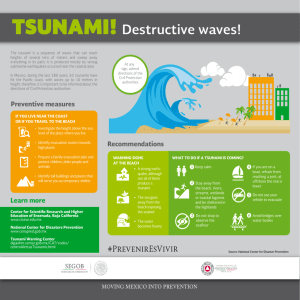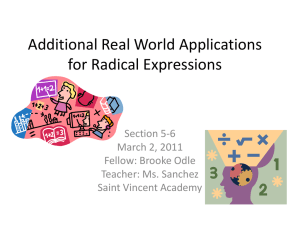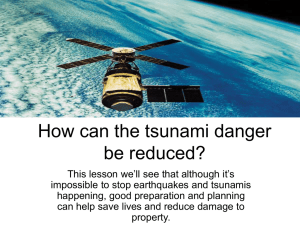Tsunamis - Gold Coast City Council
advertisement
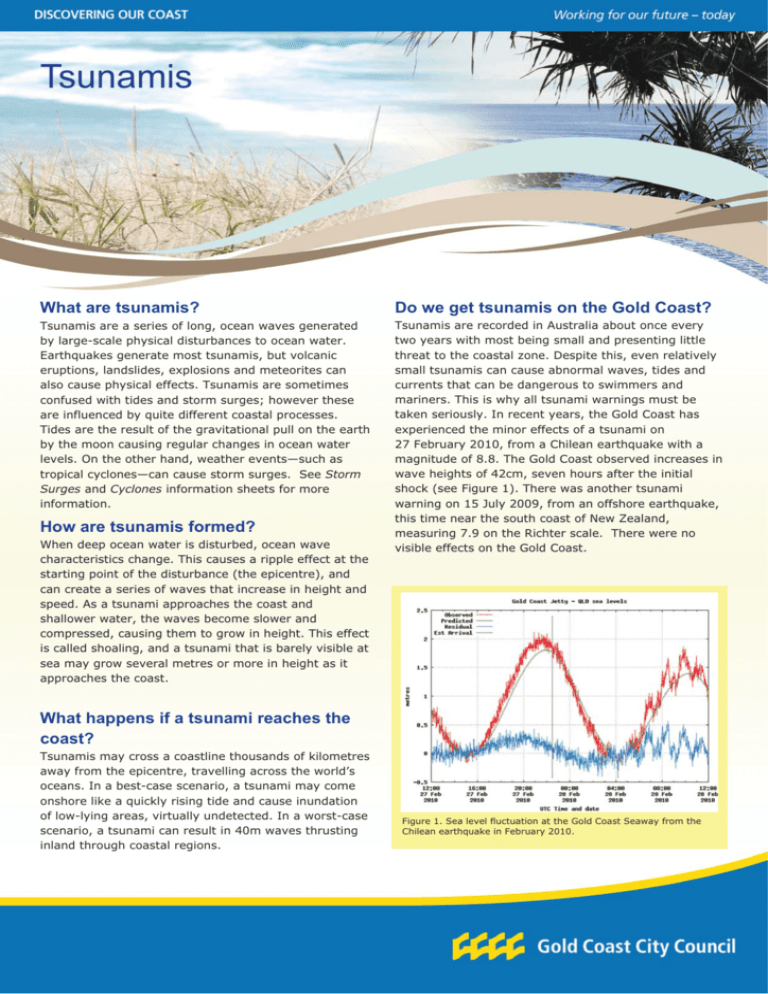
Tsunamis What are tsunamis? Do we get tsunamis on the Gold Coast? Tsunamis are a series of long, ocean waves generated by large-scale physical disturbances to ocean water. Earthquakes generate most tsunamis, but volcanic eruptions, landslides, explosions and meteorites can also cause physical effects. Tsunamis are sometimes confused with tides and storm surges; however these are influenced by quite different coastal processes. Tides are the result of the gravitational pull on the earth by the moon causing regular changes in ocean water levels. On the other hand, weather events—such as tropical cyclones—can cause storm surges. See Storm Surges and Cyclones information sheets for more information. Tsunamis are recorded in Australia about once every two years with most being small and presenting little threat to the coastal zone. Despite this, even relatively small tsunamis can cause abnormal waves, tides and currents that can be dangerous to swimmers and mariners. This is why all tsunami warnings must be taken seriously. In recent years, the Gold Coast has experienced the minor effects of a tsunami on 27 February 2010, from a Chilean earthquake with a magnitude of 8.8. The Gold Coast observed increases in wave heights of 42cm, seven hours after the initial shock (see Figure 1). There was another tsunami warning on 15 July 2009, from an offshore earthquake, this time near the south coast of New Zealand, measuring 7.9 on the Richter scale. There were no visible effects on the Gold Coast. How are tsunamis formed? When deep ocean water is disturbed, ocean wave characteristics change. This causes a ripple effect at the starting point of the disturbance (the epicentre), and can create a series of waves that increase in height and speed. As a tsunami approaches the coast and shallower water, the waves become slower and compressed, causing them to grow in height. This effect is called shoaling, and a tsunami that is barely visible at sea may grow several metres or more in height as it approaches the coast. What happens if a tsunami reaches the coast? Tsunamis may cross a coastline thousands of kilometres away from the epicentre, travelling across the world’s oceans. In a best-case scenario, a tsunami may come onshore like a quickly rising tide and cause inundation of low-lying areas, virtually undetected. In a worst-case scenario, a tsunami can result in 40m waves thrusting inland through coastal regions. Figure 1. Sea level fluctuation at the Gold Coast Seaway from the Chilean earthquake in February 2010. Who issues the warning? Australia has a comprehensive, independent tsunami warning service—the Joint Australian Tsunami Warning Centre— that is operated 24-hours a day to ensure all media, public and emergency authorities are notified of any tsunami threat to the Australian coastline. This is jointly undertaken by the Bureau of Meteorology, Geoscience Australia and Emergency Management Australia. “It doesn’t matter how experienced or how long you have been surfing in the same spot, the fear is with a tsunami you are going to get very unusual conditions and rips and it will form gutters and so on...” (Emergency Management Queensland acting chief officer, Bruce Grady)1 Types of tsunami warnings The Joint Australian Tsunami Warning Centre assesses the level of threat posed by any potentially tsunamicausing earthquakes that occur and issues a warning accordingly: 1. Ϯ͘ ϯ͘ No threat – an undersea earthquake has been detected, however it poses no threat of a tsunami to Australia and its offshore territories. Marine and immediate foreshore threat – warning of potentially dangerous waves, strong ocean currents in the marine environment and the possibility of some localised ocean overflow onto the immediate foreshore. Land inundation threat – warning for low-lying coastal areas of major land inundation, flooding, dangerous waves and strong ŽĐĞĂŶĐƵƌƌĞŶƚƐ͘ What is Gold Coast City Council doing to prepare for tsunamis? ♦ In case of a major threat, the Gold Coast City Council Disaster Management Response Unit coordinates our city’s emergency response ♦ A unique Disaster Management Centre streamlines the city’s emergency response ♦ Earthquakes in our region are continuously monitored and interpreted ♦ The centre corresponds with key stakeholders, such as the Joint Australian Tsunami Warning Centre and Emergency Management Queensland, to ensure disaster preparedness During a tsunami... ♦ Move to higher ground ♦ Do not stay on the beach ♦ If on a boat, come into shore, shelter behind a headland or enter a harbour To find out how you can prepare for a tsunami, visit goldcoastcity.com.au/disaster For more information Visit the Bureau of Meteorology website www.bom.gov.au/tsunami or call 1300 TSUNAMI (1300 878 6264) Figure 2. Australian tsunami warning service map (Source: Bureau of Meteorology 2010) 1 Lappeman, S. 2010, ‘Coast’s tsunami warning “confusing”’, Gold Coast Bulletin 2 March, goldcoast.com.au/ article/2010/03/02/194135_gold-coast-news.html/

